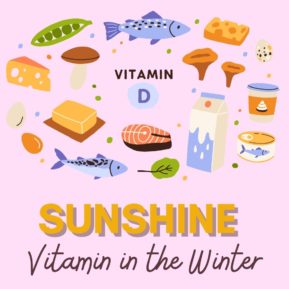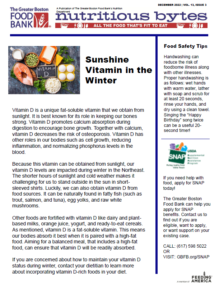What’s Your Sunshine Vitamin in Winter?
Vitamin D is a unique fat-soluble vitamin that we obtain from sunlight. It is best known for its role in keeping our bones strong. Vitamin D promotes calcium absorption during digestion to encourage bone growth. Together with calcium, vitamin D decreases the risk of osteoporosis. Vitamin D has other roles in our bodies such as cell growth, reducing inflammation, and normalizing phosphorus levels in the blood.
 Because this vitamin can be obtained from sunlight, our vitamin D levels are impacted during winter in the Northeast. The shorter hours of sunlight and cold weather makes it challenging for us to stand outside in the sun in short sleeved shirts.
Because this vitamin can be obtained from sunlight, our vitamin D levels are impacted during winter in the Northeast. The shorter hours of sunlight and cold weather makes it challenging for us to stand outside in the sun in short sleeved shirts.
Luckily, we can also obtain vitamin D from food sources. It can be naturally found in fatty fish (such as trout, salmon, and tuna), egg yolks, and raw white mushrooms. Other foods are fortified with vitamin D like dairy and plant-based milks, orange juice, yogurt, and ready-to-eat cereals.
As mentioned, vitamin D is a fat-soluble vitamin. This means our bodies absorb it best when it is paired with a high-fat food. Aiming for a balanced meal that includes a high-fat food, can ensure that vitamin D will be readily absorbed.
If you are concerned about how to maintain your vitamin D status during winter, contact your dietitian to learn more about incorporating vitamin D-rich foods in your diet.
Alaska Salmon Bake
Makes 4 servings
Ingredients
- 1 tablespoon mustard
- 2 tablespoons olive oil
- 4 teaspoons honey
- 1/4 cup breadcrumbs
- 1/4 cup walnuts, chopped
- 2 teaspoons parsley
- 4 salmon steaks (4-ounce each), thawed
- 1/4 teaspoon salt
- 1/8 teaspoon pepper
- 4 tablespoons lime juice
Directions
- Preheat oven to 450 degrees.
- In a small bowl, mix together mustard, olive oil and honey. Set aside.
- In another bowl combine breadcrumbs, walnuts and parley.
- Season salmon steaks with salt and pepper. Place them on a lightly greased sheet or broiling pan.
- Brush each steak with mustard mixture.
- Pat breadcrumb mixture onto the top of each steak.
- Bake for 10 minutes or until salmon reaches an internal temperature of 145 degrees for 15 seconds.
Check out the latest issue of Nutritious Bytes to learn more about food and recipes.

